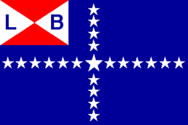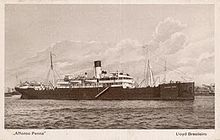Lloyd Brasileiro
| Companhia de Navegação Lloyd Brasileiro
|
|
|---|---|
| legal form | |
| founding | 1894 |
| resolution | 1998 |
| Reason for dissolution | Business abandonment |
| Seat |
Rio de Janeiro , |
| Branch | shipping |
The Companhia de Navegação Lloyd Brasileiro , mostly just called Lloyd Brasileiro or Lloydbrás , was a (mostly state-owned) Brazilian shipping company that was founded on February 19, 1894. In particular, by taking over the German ships confiscated by the entry into the war in Brazil in 1917, it became the only major shipping company in South America. In 1931 Lloyd Brasileiro was one of the 50 largest shipping companies in the world and owned 73 ships totaling 271,000 GRT.
The company was dissolved in October 1997 during the administration of President Fernando Henrique Cardoso .
history
The Brazilian admiral Arthur Silveira da Motta , Baron Jaceguay, (1843-1914) tried since 1886 to found a Brazilian overseas shipping company. This should operate two steamship lines to Europe (Northern Europe to Hamburg and the Mediterranean Sea) and actively strive to support desirable immigration to Brazil. The collapse of the Brazilian Empire and the subsequent unrest delayed the implementation of this plan. Lloyd Brasileiro was founded in February 1894 with the federal government as the main owner, to this end the existing shipping companies Empreza Transatlântica Brasileira, Companhia Brasileira de Navegação a Vapor and Companhia Nacional de Navegação a Vapor merged with the smaller shipping companies Companhia Progresso Marítimo, Companhia de Navega Estrão Estrada de Ferro Espírito Santo a Caravelas, to which the three smaller shipping companies Companhia Bahiana de Navegação, Companhia Paraense de Navegação and the Companhia Brasileira de Estradas de Ferro e Navegação were added in 1891. In fact, the main business now was Brazilian coastal traffic, including traffic in the Amazon basin . However, there was no economic success. In 1906 the plan was made to order 18 newbuildings in Great Britain and to purchase a number of used ships. Its implementation and the establishment of lines to New York and in 1910 to Portugal and then to Great Britain and Germany did not bring the economic gains and led to the complete takeover of the company by the state before the First World War.
The largest ships of the company in 1914 were the British-built Ceara (1907, 3324 BRT), Pará (1907, 3351 BRT), Sao Paulo (1907, 3583 BRT), Rio de Janeiro (1908, 3583 BRT), Bahia (1910, 3401 BRT) and Minas Gerais (1910, 3540 BRT), small passenger steamers with refrigerated cargo space for the transport of agricultural products on their voyages to Europe or the USA. The cargo ships Purus (1900, 3822 GRT), Tocantins (1901, 3837 GRT) and Tapajos (1902, 3774 GRT), acquired from the British-Brazilian Buarque Line, were added to the newbuildings in 1911 .
In addition to these nine ships over 3,000 GRT, there were four steamers over 2,000 GRT and 22 steamers over 1,000 GRT. Among these were the steamers that were used for the Cia. de Nav. Cruzeiro do Sul, Santos. The Hamburg-Süd and Hapag had this society founded in 1905 for the coastal service between Rio de Janeiro and Buenos Aires five ships ( Saturno , Orion , Jupiter and Sirio 1800-1900 GRT and for the service of Rio Grande do Sul Porto Alegre Venus of 966 GRT) in Germany. After the abandonment of the German holdings, these ships were all employed by Lloyd Brasileiro between 1908 and 1916.
Development during the First World War
The outbreak of the First World War forced the company to shorten its European line and then lead it into the Mediterranean. This change was also abandoned after Italy entered the war, especially as the Central Powers intensified their submarine warfare.
Initially, Brazil tacitly tolerated the warring powers using some uninhabited islands off its coast. British warships also ran into Brazilian ports relatively frequently. The Germans supplied their small cruisers Dresden and Karlsruhe with their merchant ships . The landing of over 400 Karlsruhe prisoners by a Hamburg-Süd steamer in Belém in autumn 1914 led the Germans to be informed that further support for their naval warfare would not be tolerated. The more than 40 German merchant ships in Brazilian ports then no longer carried out any support activities, especially since German warships no longer operated off the Brazilian coast after the loss of the Karlsruhe and the cruiser squadron until 1916. On May 22, 1917, the old steamer Lapa (ex Sparta , 1,366 GRT, 1872) of Lloyd Brasileiro, with a cargo of coffee on the way to Marseille, was stopped by the German submarine U 47 off Gibraltar and sunk as the fourth Brazilian ship .
When Brazil joined the war on the side of the Entente in 1917 , the 45 ships of the Central Powers were confiscated in the Brazilian ports and used as merchant ships by Lloyd Brasileiro. The largest ship of the Brazilian merchant navy and the shipping company was the Hapag steamer Blücher of 12,334 GRT as Leopoldina , which was made available to France in 1918 and was used by the Compagnie Générale Transatlantique in service to the USA from 1921 . In March 1923 the ship was sold to the CGT and renamed Suffren . In the service of the shipping company as the largest ship, the Bahia Laura of Hamburg-Süd remained as Caxias , then Ruy Barbosa , of 9790 GRT.
Operated by Lloyd Brasileiro, three steamers were lost to German submarines during the First World War. It was about the
- Macao ex Palatia of Hapag, 3,558 GRT, built in 1912, the sinking of which on October 18, 1917 finally triggered a state of war
- Acary ex Ebernburg of DDG Hansa, 4,275 BRT, built in 1905, on November 3, 1917 and
- Maceió ex Santa Anna of the HSDG, 3,739 GRT, built in 1910, on August 2, 1918
The shipping company between the world wars
By 1922, three more former German ships were lost in service with Lloyd Brasileiro. The worst accident was the capsizing of the Avare ex Sierra Salvada on January 16, 1922 while undocking in the port of Hamburg, in which 39 men, including 26 Brazilian seamen, were killed.
In the 1920s, the majority of the formerly German ships were gradually transferred formally to the state shipping company (33 ships, 165,133 GRT). After the war, the shipping company was again in a privatization phase, but this came to an end in the great shipping crisis. In 1931, Lloyd Brasileiro was one of the 50 largest shipping companies in the world and by far the largest shipping company in South America with 73 ships totaling 271,000 GRT. However, the shipping company only bought a few used ships and hardly received any newbuildings. The most modern ships of the shipping company in 1939 were five small, in the Netherlands built motor freighters of 2,900 GRT of the type Bandeirante .
In World War II
During the Second World War, Lloyd Brasileiro received a large number of ships that the Brazilian government had confiscated, mostly Italian and Danish ships.
The German share was small, as a large number of ships tried to reach their homeland even after the outbreak of war, in some cases only after the conquest of France. Some German ships were also sold to Brazil to allow other supply trips to German warships. The Lloyd received the modern 6000 GRT Montevideo of Hamburg-Süd, whose sister ship Porto Alegere left Santos 14 days after the outbreak of war and was able to break through to Hamburg. The other sister ship Rio Grande did not leave Rio Grande do Sul until October 1940, supplied the auxiliary cruiser Thor and brought his prisoners to France and became one of the most successful German blockade breakers . From 1940 the fleet of Lloyd Brasileiro was strengthened by more than 20 purchases from the USA.

During World War II, 30 Brazilian merchant ships were sunk by German submarines, 17 of which belonged to Lloyd Brasileiro. The first took place on February 15, 1942, when U 432 sank the 5,152 GRT Buarque des Lloyd, which was purchased from the USA in 1940, off the US coast.
As Brazil on August 22, 1942 declared war on Germany, 17 ships were sunk and now has it happened after the sinkings of Annibal Benévolo of Lloyd, Araraquara , Baependy also of Lloyd, Arará , Itagiba and Jacyra within four days by U 507 under Corvette Captain Harro Schacht off the Brazilian coast without warning. In the first three sinks, a total of 607 people died, 270 of them on the Baependy and 150 on the Annibal Benévolo .
In contrast to many other shipping companies in the post-war period with high shipbuilding prices, the company did not initially build any new ships and only commissioned the purchase of 22 new general cargo ships between 1958 and 1967, nevertheless it got into a financial crisis in the 1960s . A privatization planned in 1967 did not materialize. After an economic high in the 1970s, Lloyd Brasileiro got into increasing financial difficulties again in the second half of this decade due to the poor freight rates of the early 1980s and the heavy debt caused by the necessary new construction of container ships. At the beginning of the 1990s, the company launched a large part of the fleet and later finally ceased operations despite promised rescue efforts by the government. From the end of 1995 until the decisions of President Fernando Henrique Cardoso in late 1997 or on March 5, 1998, the company was liquidated.
literature
- Carl Herbert: War voyages of German merchant ships . Broschek & Co, Hamburg 1934.
- Arnold Kludas : The ships of the German Africa Lines 1880 to 1945 . Verlag Gerhard Stalling, 1975, ISBN 3-7979-1867-4 .
- Arnold Kludas: The history of the German passenger shipping volume II: Expansion on all seas 1890-1900 . Ernst Kabel Verlag, 1987.
- Arnold Kludas: The History of German Passenger Shipping Volume III: Leap growth 1900-1914 . Ernst Kabel Verlag, 1988.
- Arnold Kludas: The ships of the North German Lloyd 1920 to 1970 . Koehlers Verlagsgesellschaft, 1992, ISBN 3-7822-0534-0 .
- Reinhardt Schmelzkopf: German merchant shipping 1919–1939 . Verlag Gerhard Stalling, Oldenburg, ISBN 3 7979 1847 X .
- Susanne and Klaus Wiborg: 1847-1997 Our field is the world , Hapag-Lloyd AG, 1997
Web links
- Description at Navios e Portos (Portuguese)
- Administration building
- «BLUCHER» (Portuguese)
- Eight Brazilian steamers sunk by German submarines
Individual evidence
- ↑ Planos ambiciosos (port.)
- ^ Kludas: The history of the German passenger shipping. Volume III: Erratic Growth 1900-1914. P. 153 ff.
- ↑ Sinking of the Macau by U 93 .
- ↑ sinking of the acary by U 151 .
- ↑ Sinking of the Maceió by U 43 .
- ^ Accidents in the Port of Hamburg - Memorials in Ohlsdorf , May 2009
- ^ Lloyd's Register of shipping 1931/32; Der Große Brockhaus, Volume 15 (Pos-Rob) 1933, Reedereien, p. 473 ff.
- ↑ René De La Pedraja Toman: Latin American Merchant Shipping in the Age of Global Competition. Greenwood Publishing Group, 1999, pp. 116, 133, 137.
- ↑ Brazil 'committed to Lloyd Brasileiro': New company president aims to cut costs in: Lloyd's List , March 15, 1991
- ^ Lloyd Brasileiro end after a long agony in: DVZ Deutsche Logistik-Zeitung , October 25, 1997
- ↑ Entry at jusbrasil.com





